This post is the third in a series of three essays produced through David Perell’s Write of Passage Bootcamp. I joined cohort 13 as one of ten O'Shaughnessy Venture Fellows and look forward to injecting ideas and innovations from the program into The Jaunt newsletter. Thank you so much for supporting my writing!
In another life, I must have been an archaeologist or an anthropologist.
Instead of chipping away at mammoth bones or exploring ancient Roman aqueducts, my contemporary fieldwork specializes in garage sales, flea markets, and estate sales.
That’s how I met Ron.
Meeting a Person When They No Longer Live at Home
It was a late summer Friday afternoon, and I decided to visit an estate sale near the University of Denver.
Normally, I scout the week’s local estate sale offerings at an online directory. I recall seeing a post about this particular house, but nothing stood out except for a number of photos of books on Colorado's history.
Most sales are likely to be duds, but others are tantalizing to me. My eyes perk up at homes loaded with bookshelves, photographs, and other historical collectibles. These are the sales that will get me up early in the morning. In many instances, people will arrive a few hours before a sale opens, ready to be the first person in the door to get their favorite items.
Estate sales are the perfect place to build my library. Local history, Americana, travel literature, railroads, military history, Beervana, and more are just a sample of the categories I collect.
I pulled up to an average and humble one-story brick home.
Walking in, the living room was small and jammed with folks clutching books, and stacks of papers. A makeshift checkout counter was set up against the rear wall, along with glass cases of memorabilia. A woman was checking out customers and pricing items. An army dress uniform hung up with the name “Hill” on a black name tag.
When you enter an estate sale, the owner is never there to say hello. It’s just you and a sea of shoppers, hoards of people on a mission to find their idea of gold. In many cases, the owner has decided to downsize, sell the property, and move to a retirement home. In many situations, the owner has died, and family and friends hire an estate company to price and move everything within the house so it can be sold.
The bowels of the kitchen’s cupboards had been emptied, glassware and dishes stacked on counters and a table. A bookshelf stood guard to a basement stairway loaded with cookbooks and dozens of volumes about fountain pens and paperweights.
A corner den was converted into a library, with glass cases stuffed with books about Western American history, Colorado gold mining towns, railroad history, aviation, and photographers.
Guide to the Colorado Ghost Towns and Mining Camps
Island in the Rockies: The History of Grand County, Colorado to 1930
David Plowden’s Imprints: A Retrospective
Andre Kertesz: Of Paris and New York
At this point, my heart starts to kick into another zone. I’ve been to hundreds of estate sales, and I can tell you a lot about a person based on the books on their bookshelf.
I was immediately struck that there was something very unique about Mr. Hill.
He loved locomotives. He loved American landscape photography. He loved airplanes. His pulse revved at the sight of fast German automobiles.
He really, really, really loved Leica and Hasselblad cameras.
I got the sense that Mr. Hill was a student of history and had hobbies that tried to document or savor the past. I started to wager in my inner dialogue that he was either a researcher, writer, or photographer.
Estate sales favor those who move quickly.
I loaded items into my bags as fast as possible.
And then, I went to the basement. And my suspicions were confirmed. This man had to be a photographer – and a prodigious one at that.
Giant filing cabinets held Kodak slides. A desk contained notepads and stacks of black-and-white photographs.
A small utility room was converted into a darkroom, loaded with equipment and stacks and stacks and stacks of photography magazines that stretched back decades.
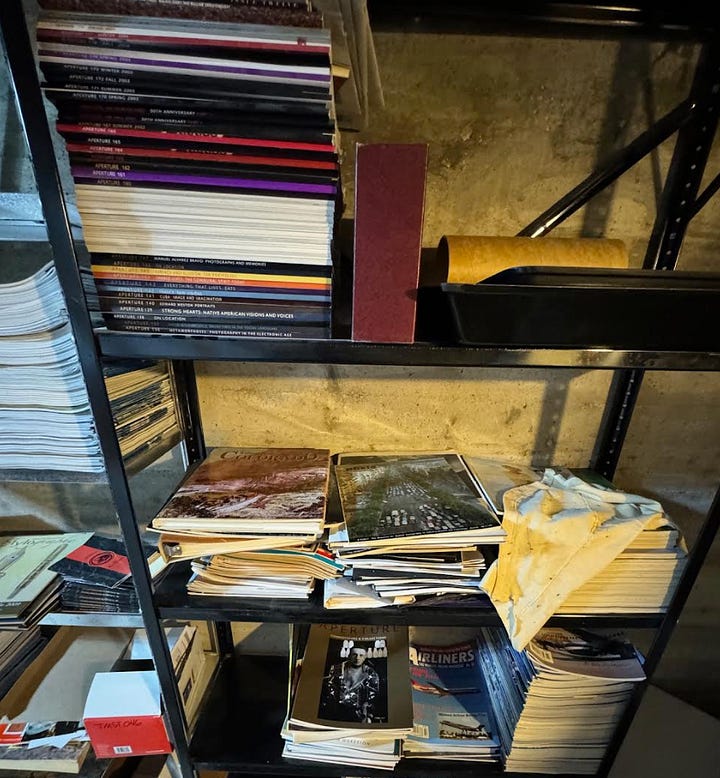

Another small room was where the puzzle started to piece together.
A shelf was filled from floor to ceiling with photo albums – each one piecing together moments in time. Each was individually priced with a bright orange dime store sticker—albums painstakingly curated, cataloged, and capturing incredible moments in time were up for sale.
Inside were beautifully, perfectly composed photographs of trains curving across mountain landscapes, abandoned gold mining towns, vintage race cars, and commercial airliners.
Back upstairs, I heard another shopper marvel and ask: “Who lived here? Was he single?”
The estate sale worker explained that he had been a lifelong bachelor. He practiced law, and because he had no marital commitments or children, he was able to enjoy many hobbies. In fact, he had hardly any remaining family, and some local friends were helping to tie up his estate and belongings many months after his passing in 2023.
There was no doubt that while his house gave the image of a modest man, the objects he accrued and collected in every room composed a picture of a man who enjoyed the finer things.
I checked out, filed away mental locations of other books and photographs I wanted, and left for the day.
When I got home, I started sleuthing.
I bought this book signed by photographer Jeff Brouws, with an inscription inside: “For my old pal, Ron—Best wishes, JB, 2003.”


My mind was blown.
As someone deeply interested in roadside architecture, vintage signs, and motels of yesterday, I was quite familiar with this author, Jeff Brouws.
I plugged in Ron Hill’s name into Google and found a few hits. I also knew of Brouws work and sent him a message on Facebook.
I started to piece together that Ron Hill was a highly accomplished author, researcher, and photographer. His primary subject area of publishing was railroads. It was evident based on the albums I had in my possession, that no matter where railroad lines went, Ron had been there to capture them forever.
He had published many books on railroading. His photos were very well-known in the railroad community, and he was known for his persistence, framing, and approach.
Brouws got back in touch and called me. It was an utter shock to get a personal phone call from a documentary photographer whose books I owned and whose work I admired deeply.
He divulged that he had grown close to Ron over the years after a chance meeting at a railroad museum in Golden, Colorado. Because of that run-in, Brouws learned to tap into his love of photography and make it a career – one that has seen him achieve great heights that have been published and exhibited in the Getty and Whitney.
Whenever Brouws stopped through Denver, he would visit Ron to see his latest work or to go on trips across the American West to capture rail cars as they hurtled to their destinations. Ron would also pen letters to Jeff about photographic ideas and topics, written of course, in one of his fountain pens.
A few years ago, as Ron got older, and before his passing in 2023, Jeff went back to Denver and took most of his entire collection and the arc of his photographic career and drove it east to the Center for Railroad Photography & Art in Madison, Wisconsin.
The center received Ron’s collection, and curators have spent the last few years archiving and cataloging it in their center. Tens of thousands of images comprised calendars and numerous books. The Ronald C. Hill collection contains 27,000 images documenting 60 years of railroad history across Western America and stretches of Western Canada.
I contacted them, and their head archivist shared more details about the type of photographer and man Ron was.
Using primarily Leica and Hasselblad cameras (of which he was an ardent devotee), Ron created an incredible body of both color and black-and-white photography. While trains and railroads were his primary subjects, he also photographed airplanes extensively as well as other modes of transportation, infrastructure, and landscapes from the 1950s through the 2010s. He covered Colorado’s railroads extensively throughout his life, and he also spent considerable time in Montana and western Canada, as well as Europe. He frequently sought locations that conveyed the geographic features and other characteristics of western railroads, and he liked to return to the same locations over the years to record their seasonal variety and changes through time.
A Man Of Another Time and Era
I returned to Hill’s estate the next two days after the sale started.
I saw how much history and ephemera Hill owned, and I went into fight mode, hoping to salvage as much of his photographic work and books as I could and incorporate them into my collection to learn about him, study his work, and see what places he had captured with his trusty cameras.
I bought most photo albums in the basement and boxes full of books and negatives. My car trunk was stuffed with various artifacts of Ron’s work, and I was excited to research and study them.
I spent weeks poring over the photos and ephemera I purchased at his estate sale. My favorite photos are black and white prints of tiny specks of towns in Kansas – little crossroads of hundred-person villages with grain elevators, rail depots, and tiny post offices. Each of the photos is from the 1950s and captures what life was like in rural America. It made me wonder how much these towns have changed—towns including Milford, White City, Dunlap, and Wilsey.
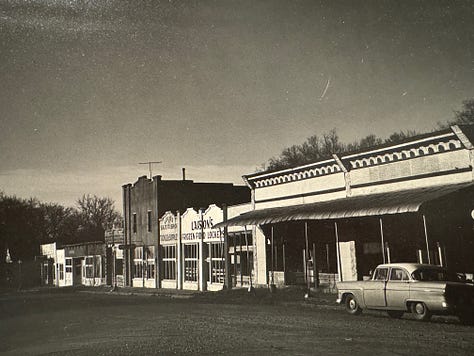
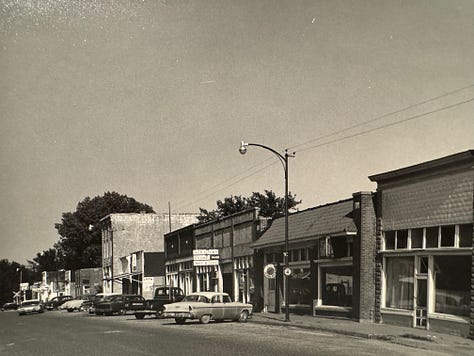
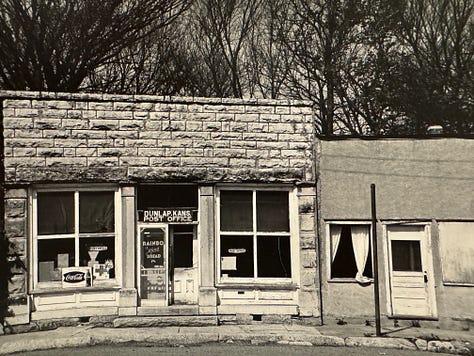
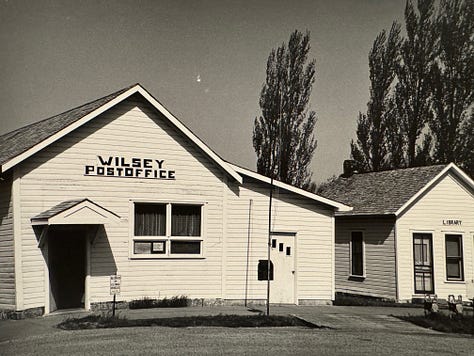

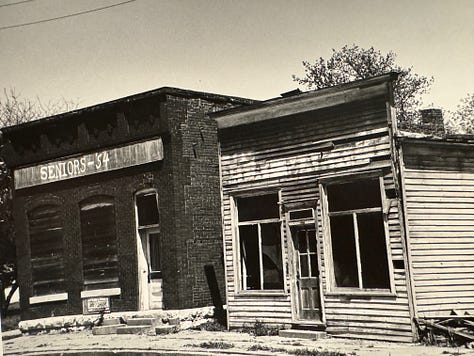
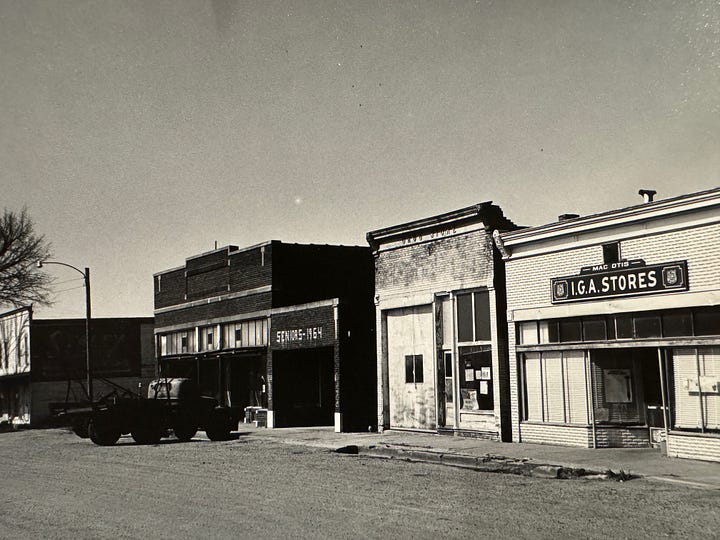

Ron appreciated change as one of his photographic themes, and now I, too, will pick up that mantle, revisit these towns, stand where he stood, and capture an image from 2024 to see what life looks like now.
Doors To Another World, Another Life
You can learn a lot about someone by walking into an estate sale.
In my case, I learned way more than I ever imagined.
To be human is to buy and consume.
To collect and preserve.
Our homes are full of all the requisite items for survival, necessity – leisure, and enjoyment.
Over the years, our basements, attics, and garages have acquired a litany of life’s possessions. The cycles of life dictate what we need and when. Marriage, children, retirement – no matter the season of life, things start accumulating.
And at some point, we purge or die. There’s no middle ground in this equation.
Once we cede control of the objects we’ve bought, there are a few avenues to relinquish them and put them into a new orbit. We can donate them, pass them to family, trash them, or sell them at a garage sale.
In many instances, the collection of our lives that fills our bookshelves and cupboards never sees a voluntary transfer of ownership. Untimely death and other misfortunate life events cause these items to hurtle into an uncertain future.
The next stop in the evolution of our belongings is often an estate sale – a company that comes in on behalf of a family member or relative to liquidate the items within the dwelling as fast as possible.
I couldn’t help but wish I had met Ron. But in a way, I already have.
My chance visit to his estate sale helped introduce me to him and his incredible work. I also grew closer to his work style and methods as I looked at each one of his photos.
If I am lucky, I’ll get to help shine a light on his work by adding to his story in an interesting and unique way. Perhaps its with this story or maybe a project with the images he captured in Kansas.
I drove by his house a few weeks after the estate sale, and the brick bungalow sat eerily lonely. The insides were emptied of every item, and the lawn was no doubt awaiting the planting of a for-sale sign in the front yard. A Zillow listing shows that his house has been officially listed—every photo of a staged room was miles away from the beautiful hodge-podge of books, photos, and history that I was lucky to see.
But the stories Ron created, crafted, composed, and printed in that modest home will always be a part of my world.






Wow this is my first time learning about an estate sale and it sounds like a hidden treasure! So jealous of all the photography books you got.
P.S. I do a lot of photography too. Let's definitely link up sometime!
This is an incredible story, Taylor. It's fascinating what you can learn through piecing together the stories of others through their belongings. Great read.